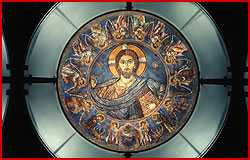Detachment of wall paintings

The detachment of wall paintings involves the removal of a wall painting from the structure of which it formed part. Once a common practice, with the move towards preservation in situ, detachment is now largely restricted to cases where the only alternative is total loss. According to the International Council on Monuments and Sites (ICOMOS), "detachment and transfer are dangerous, drastic and irreversible operations that severely affect the physical composition, material structure and aesthetic characteristics of wall paintings. These operations are, therefore, only justifiable in extreme cases when all options of in situ treatment are not viable."[3]
Origins
Vitruvius records how in Sparta, in 59 BC, "paintings have been taken out of certain walls by cutting through the bricks, enclosed in wooden frames, and brought to the Comitium".[4] A century later, apprised of paintings of Atalanta and Helen without drapery and "enflamed with lust", Caligula attempted to carry them off, but was prevented by the makeup of the plaster.[5] Maiuri cites examples of wall paintings in wooden frames excavated at Pompeii, a precursor to what was to follow in the 18th and 19th centuries.[6][7] The practice of detachment, in abeyance or undocumented for a millennium, was revived in Renaissance Italy, with several instances recorded by Vasari.[8]
Motivation
In their study, Mora, Mora, and Philippot cite four reasons for the "over-use" of detachment: the 19th-century division of the arts that privileged a "painting" divorced from its architectural and historical context; insensitivity to the aesthetic consequences, often partially concealed by restorers; the curiosity of art historians looking for sinopie; or perceived savings relating to the initial cost of treatment.[9] Commercial gain and exploitation as consumer goods by collectors, dealers and restorers provides another possible incentive.[10]
Changing values
As the values of a society change, so to does its attitude towards works of the past. A notable example is the murals in the British Columbia Parliament Buildings painted by George Southwell between 1932 and 1935. They depict "seven virtues" of British Columbia's settlers during its colonial period. The way they depict the aboriginal peoples of the area is controversial, however. They murals have since been covered and the Legislative Assembly has voted to remove them from the building.
Techniques

There are three main methods, typically referred to by their Italian terms, namely stacco a massello, involving detachment and removal of painting, render, and some or all of the mural support; stacco or detachment of the painting with render alone; and strappo, lit. "tearing", lifting of only the paint layer, attached to a facing with adhesive.[14] In each case the resulting material must be applied to a new support.[15]
Criticisms
Minimum intervention and reversibility are core conservation ethics that favour preservation in situ.[16][17] Detachment breaks the intrinsic link between wall paintings and architecture; causes irreversible physical damage to the texture, topography, and tone of the painting; leaves a void in the stripped interior; with the introduction of new materials, typically leads to a cycle of retreatment; and has resulted in "many transfers in terrible condition that serve as examples of serious, albeit unintentional, maltreatment".[18]
See also
- Conservation-restoration
- Transfer of panel paintings
References
- ↑ Weyl Carr, Annemarie (1991). A Byzantine Masterpiece Recovered: The Thirteenth-Century Murals of Lysi, Cyprus. Menil Collection. ISBN 978-0-292-78118-4.
- ↑ "The Repatriation of the Wall Paintings of the Church of Agios Euphemianos, Lysi". Department of Antiquities. Retrieved 6 July 2012.
- ↑ "Principles for the Preservation and Conservation-Restoration of Wall Paintings (Article 6: Emergency Measures)". ICOMOS. 2003. Retrieved 13 February 2012.
- ↑ "Vitruvius, De Architectura II.8.9". Perseus Project. Retrieved 13 February 2012.
- ↑ "Pliny the Elder, Natural History XXXV.6.17-18". Perseus Project. Retrieved 13 February 2012.
- ↑ Maiuri, Amedeo (1940). "Picturae Ligneis Formis Inclusae: Note sulla Tecnica della Pittura Campana". Atti della Accademia dei Lincei (Accademia dei Lincei) 18 (7-10): 138–60.
- ↑ Moorman, Eric (1991). "Destruction and restoration of Campanian mural paintings in the 18th and 19th centuries". In Cather, Sharon. The Conservation of Wall Paintings. Getty Conservation Institute. pp. 87–102. ISBN 0-89236-162-X.
- ↑ Mora, Paolo; Mora, Laura; Philippot, Paul (1984). Conservation of Wall Paintings. Butterworths. p. 260f. ISBN 0-408-10812-6.
- ↑ Mora, Paolo; Mora, Laura; Philippot, Paul (1984). Conservation of Wall Paintings. Butterworths. pp. 245f. ISBN 0-408-10812-6.
- ↑ Brajer, Isabelle (1999). "Aspects of reversibility in transferred paintings". In Oddy, Andrew & Carroll, Sara. Reversibility - Does it Exist?. British Museum Press. pp. 64f. ISBN 0-86159-135-6.
- ↑ Jones, Sam (5 August 2005). "Spray can prankster tackles Israel's security barrier". The Guardian. Retrieved 6 July 2012.
- ↑ Mora, Paolo; Mora, Laura; Philippot, Paul (1984). Conservation of Wall Paintings. Butterworths. pp. 2ff. ISBN 0-408-10812-6.
- ↑ Sven Sandström (1963). Levels of Unreality: Studies in structure and construction in Italian mural painting during the Renaissance. Uppsala. pp. passim.
- ↑ Mora, Paolo; Mora, Laura; Philippot, Paul (1984). Conservation of Wall Paintings. Butterworths. pp. 246–260. ISBN 0-408-10812-6.
- ↑ Mora, Paolo; Mora, Laura; Philippot, Paul (1984). Conservation of Wall Paintings. Butterworths. pp. 262–281. ISBN 0-408-10812-6.
- ↑ Brajer, Isabelle (2002). The Transfer of Wallpaintings; based on Danish experience. Archetype Publications. ISBN 978-1-873132-43-2.
- ↑ Michaelides, Demetrios, ed. (2003). "Philosophies favouring in situ conservation". Mosaics make a Site: The conservation in situ of mosaics on archaeological sites. ICCM. pp. 17–29. ISBN 92-9077-179-8.
- ↑ Brajer, Isabelle (1999). "Aspects of reversibility in transferred paintings". In Oddy, Andrew & Carroll, Sara. Reversibility - Does it Exist?. British Museum Press. pp. 63–71 (p. 65 for quote). ISBN 0-86159-135-6.